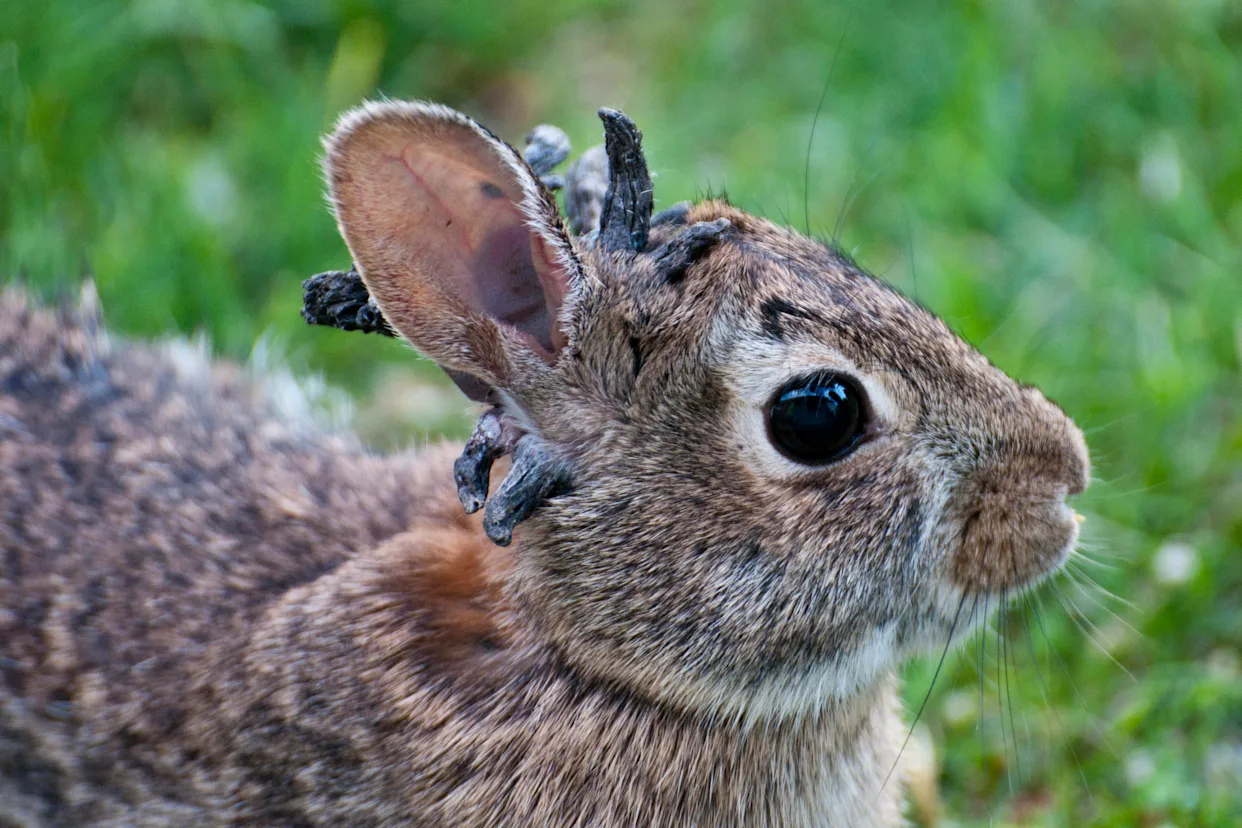Something weird is happening in Colorado. Residents in Fort Collins have been spotting Colorado rabbits tentacles growing from their heads like something out of a horror movie. But before you start planning your escape to safer territories, wildlife experts want you to know there’s a perfectly normal explanation for these bizarre bunnies.
These aren’t your typical cute, fluffy Easter bunnies hopping around suburban lawns. We’re talking about wild cottontail rabbits sporting dark, spiky growths that look like black tentacles or horns sprouting from their faces and mouths.
What’s Really Going On?
The Colorado rabbits tentacles aren’t actually tentacles at all – they’re wart-like growths caused by something called the Shope papilloma virus. Think of it like the rabbit version of getting warts, except way more dramatic and scary-looking.
“It looks like it was black quills or black toothpicks sticking out all around his or her mouth,” said Fort Collins resident Susan Mansfield, who’s been watching one infected rabbit for over a year. “I thought he would die off during the winter, but he didn’t. He came back a second year, and it grew.”
The virus spreads through bug bites – mosquitoes, ticks, and fleas can all pass it along. So basically, these Colorado rabbits tentacles are the result of really bad luck with summer insects.
Don’t Panic (Seriously)
Here’s the good news: Colorado Parks and Wildlife officials say the Colorado rabbits tentacles virus can’t jump to humans or pets. It’s rabbit-specific, kind of like how you can’t catch a cold from your goldfish.
“The virus is mostly benign in rabbits,” explained Colorado Parks and Wildlife spokesperson Kara Van Hoose. “The animal can clear the virus from its system on its own.”
Most rabbits live normal lives with these growths, unless they get so big they interfere with eating or seeing. That’s when things get tricky.
The Jackalope Connection

Plot twist: Colorado rabbits tentacles might explain one of North America’s most famous mythical creatures. Scientists think the papilloma virus could be behind jackalope legends – those stories about rabbits with deer antlers.
Back in the 1930s, some brothers named Ralph and Doug Herrick started selling fake jackalope made from rabbit bodies and deer antlers. But the real Colorado rabbits tentacles virus was probably inspiring these stories long before anyone thought to make money off them.
The growths can look remarkably similar to small antlers or horns, especially when they’re just starting to develop. It’s easy to see how someone spotting infected Colorado rabbits tentacles from a distance might think they’d found something magical.
Summer Bug Season Makes It Worse
The timing of these Colorado rabbits tentacles sightings isn’t random. Summer means more mosquitoes, ticks, and fleas – all the bugs that can spread this virus between rabbits.
This year’s tick season has been particularly brutal across North America, which explains why more people are noticing Colorado rabbits tentacles now. When bug populations explode, virus transmission goes up too.
Wildlife officials have been tracking infected Colorado rabbits tentacles cases for years, but residents are just now paying attention because the growths look so alarming in photos shared on social media.
What Canadians Should Know
While these Colorado rabbits tentacles cases are happening south of the border, Canadian wildlife can get similar infections. The papilloma virus affects cottontail rabbits across North America, including populations in southern Canada.
If you spot unusual growths on wild rabbits in your area, don’t try to help them. Colorado rabbits tentacles might look disturbing, but interfering usually makes things worse for the animals.
Canadian pet rabbit owners should keep their animals away from wild rabbits and make sure they’re protected from tick and flea bites. Domestic rabbits can catch this virus too, and it tends to be more serious in pet breeds.
The Science Behind the Scary Look
The Colorado rabbits tentacles virus creates growths made of keratin – the same stuff that makes up your fingernails and hair. These dark, twisted projections can grow several inches long and look absolutely terrifying up close.
But here’s the thing: most of the infections clear up on their own over time. The rabbit’s immune system eventually fights off the virus, and the growths fall off naturally.
Problems only happen when Colorado rabbits tentacles growths appear around sensitive areas like the eyes or mouth, making it hard for the animals to see or eat.
What Not to Do
Wildlife experts are pretty clear about this: don’t touch Colorado rabbits tentacles cases if you find them. Don’t try to help, don’t attempt to remove the growths, and definitely don’t bring infected rabbits home thinking you can nurse them back to health.
“We just encourage people to follow general wildlife safety principles,” Van Hoose said. “If a rabbit with SPV is seen in the wild, leave it alone.”
Taking photos from a safe distance is fine, but keep your hands to yourself and your pets away from infected Colorado rabbits tentacles.
Looking Forward
The Colorado rabbits tentacles phenomenon will probably stick around as long as summer bug season continues. Wildlife officials expect to see more cases through August and September before things calm down in cooler weather.
This isn’t a new problem – scientists have been studying Colorado rabbits tentacles virus since the 1930s. It’s just getting more attention now because people love sharing weird wildlife photos online.
Bottom Line
They might look like something from a nightmare, but they’re really just an unfortunate result of rabbits getting bit by the wrong bugs at the wrong time. The infected animals usually recover fine, humans and pets stay safe, and life goes on pretty normally for everyone involved.
Next time you see photos of Colorado rabbits tentacles making the rounds on social media, you’ll know exactly what’s happening – and why there’s no need to lose sleep over tentacle bunnies taking over the world.
